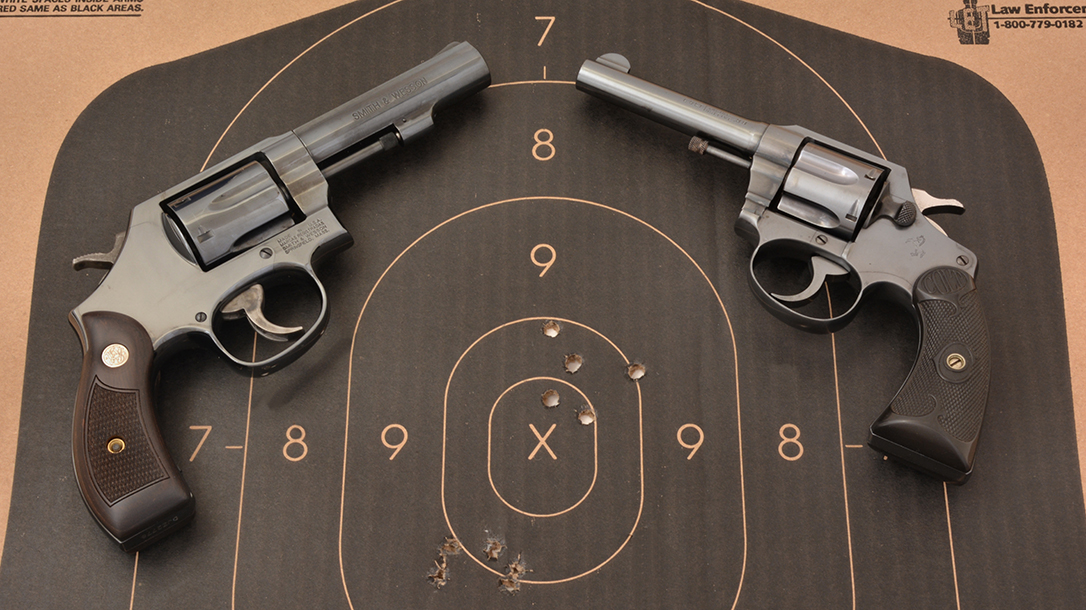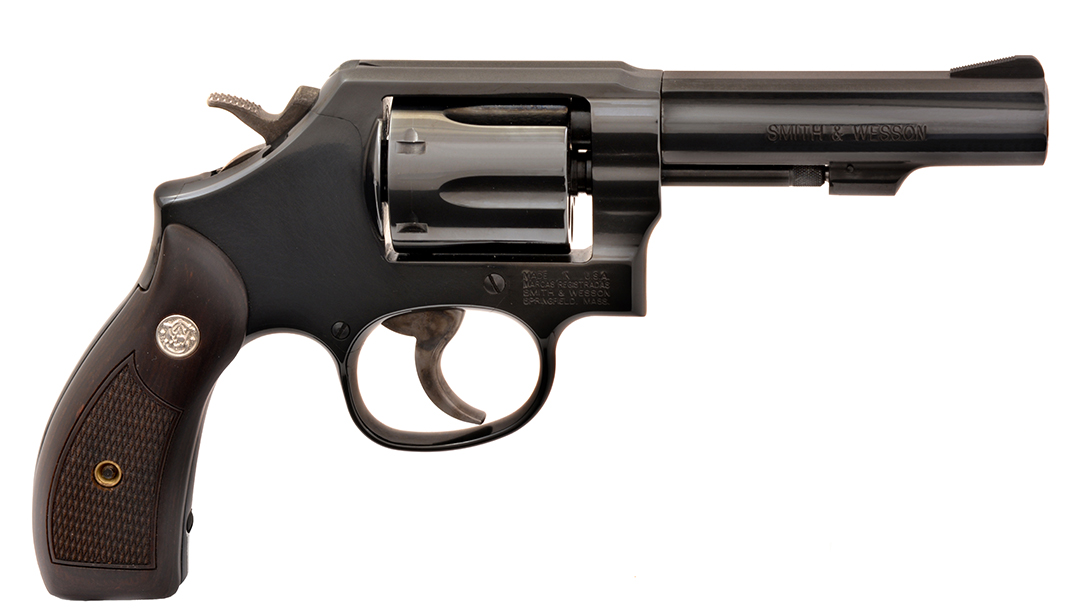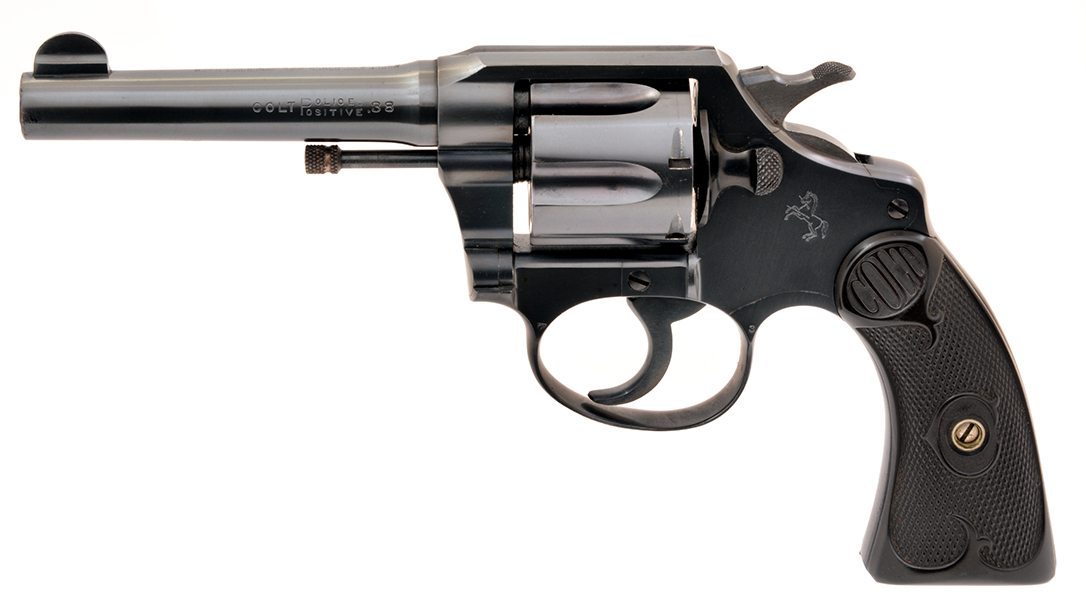Like Colt’s famous Single Action Army and first double-action revolvers, the Models 1877 and 1878, the first swing-out-cylinder revolver was designed and patented by William Mason, Colt’s brilliant armory superintendent. Mason’s patents dated November 15, 1881, and December 6, 1881 for the swing-out cylinder. When Mason’s design was put into production in 1889, the U.S. Navy immediately adopted new Colt double-action as its standard-issue sidearm; it became known as the Model 1889 Navy. It was initially chambered in .38 Long Colt and .38 Short Colt.
In 1892, Colt introduced the improved New Model Navy and Army revolvers, and the U.S. Navy and Army ordered the latest .38 Colt pistols. This continued an unbroken chain of supplying revolvers to the U.S. military since 1855, when the .36-caliber Colt Model 1851 Navy became the first standard-issue sidearm. Colt retained that honor for 130 years until 1985, when the Colt Model 1911A1 was replaced by the Beretta 92F.
Advertisement — Continue Reading Below
Colt produced various .32- and .38-caliber revolvers with swing-out cylinders from 1892 through 1905, but for law enforcement and personal protection, the most significant and enduring change came in 1905 with a model that would become synonymous with lawmen: the Colt Police Positive.
Following the .32 Colt New Police introduced in 1896, the Police Positive was an improved design with the cylinder rotating clockwise (unlike counterclockwise like previous models), a larger, rounded-contour cylinder release (beginning in 1909) and a positive lock that prevented the firing pin from coming in contact with the cartridge unless the trigger was pulled. The pistol’s internal safety and safety lever blocked the hammer, preventing an accidental discharge if the gun was dropped. In the Old West, it was common to carry a single action (SA) with the hammer on an empty chamber; it was also advised to do so even with double-action (DA) models before the Police Positive.
As noted by the R.L. Wilson in The Book of Colt Firearms, the Police Positive .38 served two purposes. First, it succeeded the .38 Colt Model 1877 Lightning DA/SA revolver, which had been discontinued at the end of 1904. Second, to quote a Colt catalog from 1905, “It will meet the great demand for an arm similar to the New Police, caliber .32, but larger in bore, with the greatest penetration, velocity and range. As a .38-caliber Pocket Revolver, it has no equal.” And it didn’t.
Advertisement — Continue Reading Below
The Colt Police Positive
Built on Colt’s D-frame, the Police Positive was regarded as a small-frame revolver. It remained in production until 1943, with sales surpassing 406,000. It also provided the frame from which the Colt Police Positive Special, Banker’s Special and Detective Special models were based.
Although 2-, 5- and 6-inch versions were offered, the 4-inch-barreled Police Positive became the handgun of choice for law enforcement for almost 40 years. In fact, from 1905 to the early 1920s, there were already more than 150,000 Police Positive revolvers in use. By the time production ended, it was by far the most ubiquitous Colt revolver carried by civilians and lawmen alike.
The 4-inch-barreled Police Positive — chambered in .38 Colt New Police, a version of the .38 S&W — proved to be an ideal carry gun or backup to a larger-caliber Colt Single Action. With an overall length of 8.5 inches and weighing just 22 ounces empty, it was a light pistol to carry. The Police Positive model was also available in the lighter .32 Colt and the new, more powerful .38 Special beginning in 1908, which S&W had developed in 1902 as a more powerful cartridge for use by law enforcement. So, Colt extended the Police Positive’s frame and cylinder to accommodate the longer, more powerful rounds. Colt manufactured the .38 Police Positive Special until 1995, carrying the design for a remarkable 88 years. In that time, Colt produced more than 1.5 million revolvers.
Advertisement — Continue Reading Below
S&W Joins The Fray
Colt and Smith & Wesson tried to compete with each other in the late 1800s by offering newer, more innovative revolvers to capture the lion’s share of the market, but then, in 1899, S&W unveiled its first .38-caliber K-Frame — the Military & Police.
Three years before the more conventional .38-caliber K-Frame, S&W had introduced the I-Frame. The 1896 models were chambered for the .32 S&W, and the cylinder was released by pulling the end of the ejector rod forward. The thumb release lever used today replaced the design on the second model in 1903,. In 1899, the Military & Police became the greatest competitor to Colt for the military, law enforcement and civilian handgun markets.
Advertisement — Continue Reading Below
Through generations of K-Frame Military & Police models spanning 120 years, the venerable .38 Special has remained a staple of the S&W line, with the .38 Military & Police (pre-Model 10) being produced until 1957, when the Model 10 designation was established. The Model 10 remained a direct competitor to the Colt Police Positive Special until Colt discontinued its double-action model. By the early 2000s, Colt had ended all double-action revolver production, leaving the market to S&W. Of course, Colt rejoined the competition last year with its new DA/SA Cobra.
Slugging It Out
I got my hands on a circa-1924 Colt Police Positive chambered in .38 Colt New Police (.38 S&W) and the latest version of the S&W Model 10 in .38 Special. Obviously, this is a ballistics mismatch, but I thought it’d be interesting to compare Smith vs. Colt revolvers for their handling and accuracy.
While both revolvers are 1.25 inches wide and sport 4-inch barrels, the Colt is slightly smaller and lighter overall than the S&W. This makes the Colt a bit more carry friendly — if you’re inclined to pack a vintage Colt revolver.
Advertisement — Continue Reading Below
The S&W has a wide ramp front sight while the Colt uses a narrow half-moon. Both revolvers have integral rear sights, with the Colt’s being considerably smaller than the S&W’s. On smaller details, the Colt is more elegant in design, with its rounded cylinder release and trigger shoe, and exposed ejector. Both guns also have square butts, with the Colt sporting checkered hard rubber grips and the S&W using wood.
Results
To keep some balance between the guns and the 94 years separating them, I ran the shooting test with lead round-nose (LRN) cartridges: Remington 146-grain .38 S&W rounds for the Colt, and Winchester 150-grain and Freedom Munitions 158-grain rounds for the S&W.
The Police Positive obviously had a performance handicap against the .38 Special, but it still sent 146-grain bullets downrange at an average velocity of 650 fps. The 150-grain .38 Specials clocked an average velocity of 746 fps. The 158-grain .38 Specials were in the 790-fps range.
Advertisement — Continue Reading Below
The old Colt Police Positive’s recoil was modest, and it shot a little low at 15 yards. The best five-shot group measured 1.13 inches. The Model 10, with its heavy barrel and greater overall weight, was also light on recoil, delivering slightly wider groups. Using the 158-grain rounds, the Model 10’s best five-shot group — just above the point of aim in the 10- and X-rings — measured 1.38 inches.
As you can see, despite being older by 94 years, the old Colt Police Positive was able to match the accuracy of the S&W Model 10 — a newer version of an old rival. Time has proven to be relative where these two classic revolver designs are concerned. Special thanks to Mike Harris of Allegheny Trade Co. in Duncansville, Pa., for the circa-1924 Colt Police Positive used here, and to Smith & Wesson for the new Model 10.
Colt Police Positive Specifications
Caliber: .38 S&W
Barrel: 4 inches
Overall Length: 8.5 inches
Weight: 22 ozs.
Grips: Checkered Rubber
Sights: Fixed
Action: DA/SA
Finish: Blued
Capacity: 6
MSRP: N/A
Advertisement — Continue Reading Below
Smith & Wesson Model 10 Specifications
Caliber: .38 Special
Barrel: 4 inches
Overall Length: 8.9 inches
Weight: 34.4 ozs.
Grips: Wood
Sights: Fixed
Action: DA/SA
Finish: Blued
Capacity: 6
MSRP: $739
This article is from the September/October 2018 issue of Combat Handguns Magazine, on sale now. Grab your copy at OutdoorGroupStore.com.


























